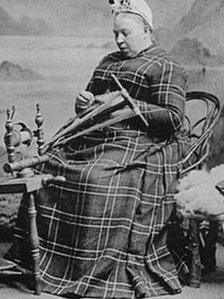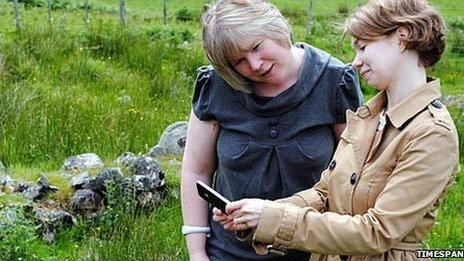Highlands' rioting women could gain greater recognition
- Published

Gaelic poet Big Mary of the Songs wrote morale boosting protest songs
Highland women who rioted in the 18th and 19th centuries could gain greater recognition through new work by academics and historians.
Widows and soldiers' wives were among those who resisted landowners' moves to clear land of people so new farms could be created to boost productivity.
In some cases women were beaten by police and pursued by marines.
Academics, such as Elizabeth Ritchie, say resistance led by women has still to be fully understood.
The Highland Clearances from the 1750s to about 1855 saw some families, a number led by women, refuse to leave land on which they had raised free-roaming cattle for generations.
There were further protests over land rights during the Crofters' War in the 1880s.
In some incidents, women helped to humiliate sheriff officers by stripping them naked and threw clods of earth and stones at police officers.
Bloody clashes during these periods included an incident at Greenyards, near Ardgay in 1853, that became known as the Massacre of the Rosses, external, and the Battle of the Braes on Skye in 1882.
The latter event saw about 50 police officers, sent from Glasgow to Skye, baton charge a group of men and women trying to stop the police leave the island with a small number of arrested crofters. The crowd had attacked the officers with stones.
Victorian Gaelic poet Màiri Mhòr nan Òran, external - Big Mary of the Songs - wrote about the confrontation for one of her best known songs.
Òran Beinn Lì, Song of Beinn Lì in English, includes the line: And the gentlest women most graceful in movement, their heads were broken on the braes of Beinn Lì.
Women found themselves on the front line of several protests because men were either working away from home, in military service, or had died.
The later Clearances occurred during the Napoleonic Wars of 1803 to 1815.
Highlanders also served in the British armed forces during the Crimean War of the 1850s . The conflict's human cost included 25,000 British dead.
The wars left widows and soldiers' wives to fight battles on the home front.
The demonstrators were charged with rioting and one government minister described the females involved as viragos - aggressive women.
Timespan Museum in Sutherland has been gathering accounts of women's resistance as part of a wider project to mark the 200th anniversary of the Clearances in Strath of Kildonan.
They include a more recent example where a woman helped to wrestle the coat from a sheriff officer and dunked it in a herring barrel during opposition to an eviction just after World War I.
Called Museum Without Walls, external, the project will use social networking sites Facebook, Twitter, a new website and a smartphone app to help mark the anniversary in 2013.
Academics and historians believe much has still to be understood about women's part in the troubles and how they also influenced the Highland economy of those times.
Eric Richards, a professor of history at Flinders University in Adelaide who has written extensively on the Highland Clearances, looks at the role of Highland women in a new and yet to be published paper on women and riotology.
In his paper, Women, Riots and the Pre-Industrial Economy, Prof Richards recalls episodes of women rioting at Clashmore in Sutherland.
One incident in 1856, saw a removal party repelled by the community's women who had "turned out with violence and virulence".
The troubles continued in later years with women often leading the skirmishes, said Prof Richards.
The then under-secretary for Scotland sought to make an example of them.
He described the women as viragos who had been treated "too chivalrously".
In 1887, damage caused to dykes and fences of a new farm led to calls for the government to send in marines.
The crew of a gunboat called The Jackal was sent to capture Hugh Kerr, a ringleader of rioting, before another warship's crew arrested Kerr's wife in 1888.
Prof Richards said Highland women were not only key to resistance against evictions, but also the economy of the region's most remote areas.
He added: "But exactly what women were doing in this society I am at a loss because there has been no research on this subject - feminist or otherwise.
"I do know that there were a lot of widows on the edge of poverty, that many of the men were away fishing for much of the time.
"And that the gender balance in the population at large was in favour of women."

Timespan staff have been developing a phone app for its Clearances project
Dr Ritchie, a lecturer at the Centre for History at the University of the Highlands and Islands in Dornoch, said there were opportunities for further research through the new university's postgraduate level short course, Contemplating the Clearances, external.
She said: "I think the resistance to clearance is not well known.
"We all know people were cleared and people were evicted, but there is not much general knowledge that there was often some resistance to them."
'Absolute nudity'
On the role of women, Dr Ritchie said: "I do think their stories have been forgotten and I think there is scope to tell some of these stories."
She said the women's success varied.
During 1853 attempts were made to clear families at Coigach in Wester Ross and Greenyards, near Ardgay, in Strathcarron.
Coigach was a rare victory for the people over a landlord.
The community defied orders to leave and stripped a sheriff officer of his clothes.
Quoting from material written at the time, Dr Ritchie said: "The summonses were forcibly taken from him and destroyed and himself grossly maltreated, but fortunately without any serious injury to his person.
"The officer was entirely stripped of his clothes by these rebels and was put into the boat in which he went to Coigach in a state of absolute nudity."
Dr Ritchie speculates that being stripped in front of the opposite sex added to his humiliation.
Greenyards, however, was dubbed a "massacre".
A crowd of 300 - about 200 of them women - confronted a sheriff and about 35 men sent to clear the community.
The women stood at the front armed with stones and behind them were men carrying sticks.
Dr Ritchie said according a report in the Inverness Courier at the time a police superintendent had tried to reason with the crowd.
When the mob refused to disperse, policemen used their batons.
The newspaper reported that women were the "principal sufferers" of the clash and 15 to 16 of them were seriously injured.
One woman was "alive in a precarious position", the Courier said.
The injured women were briefly imprisoned in Tain before being bailed.
Aberdeenshire-based author Maggie Craig believes the spirit Highland women showed in the 18th and 19th centuries could be traced to an earlier period of turbulence in Scotland.
Craig researched Jacobite women of 1745-46 for her book Damn Rebel Bitches.
Craig said: "There were also lots of ordinary women who went with their menfolk when the Jacobite army went into England.
"Of the things I found when I was researching the book was lists and lists of women caught when the red coats were pursuing Jacobite army on its retreat back to Scotland.
"They were thrown into prison in places like York, Carlisle and Lancaster.
"On these lists were young women in their 20s and 30s, sometimes with their children."
"Many of these women were transported to the West Indies."
After the Battle of Culloden, the homes of Jacobites and their sympathisers were raided and destroyed by government troops.
Women in Craig's book include clan chief's wife Isabel Haldane who wrote an angry letter to a chief on the government side after her home was ransacked.
Craig said: "I think we often forget that nowadays we lead comparatively quite comfortable lives but running a house was a really difficult occupation in those days because you didn't have shops, you had to grow your own food.
"The home was so important to women of the 1700s. I can see them defending their homes to their last breath.
"That was what the whole aim of their lives was about - it was about preserving the home."
- Published11 July 2011